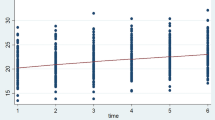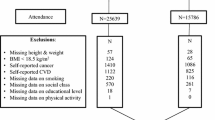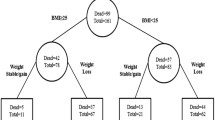Abstract
The aim of the study was to assess the performance of weight related nutritional markers [reported involuntary weight loss (WL) greater than 10%, measured WL and body mass index (BMI)] in predicting survival at AIDS stage. The three anthropometric indices were used as time dependant variables in Cox models to predict survival at AIDS stage. The studied sample included 630 HIV1-infected individuals of a prospective cohort of those 421 died (median survival at AIDS stage: 19.9 months). After adjustment for usual prognostic factors of survival, the reported WL greater than 10% was a pejorative predictor of survival (hazard ratio (HR) 2.4; 95% confidence interval (CI): 1.9–3.0). For measured WL <5%, between 5 and 10% and ≥10% of baseline weight compared with no WL, HR were respectively, 1.9 (CI: 1.4–2.6), 3.3 (CI: 2.4–4.4) and 6.7 (CI: 5.2–8.6). The HR of death were 2.2 (CI: 1.6–3.0) for BMI between 16 and 18.4 kg/m2and 4.4 (CI: 3.1–6.3) for BMI <16 compared to normal BMI (≥18.5). Even a limited WL measured at a given point in time during follow up increases the risk of death at the AIDS stage. Simple cross-sectional measures of BMI have a good predictive value of survival.
Similar content being viewed by others
References
Hoover DR, Saah AJ, Bacellar H, et al. Clinical manifestations of AIDS in the era of pneumocystis prophylaxis. Multicenter AIDS Cohort Study. N Engl J Med 1993; 329: 1922-1926.
Serwadda D, Mugerwa RD, Sewankambo NK, et al. Slim disease: A new disease in Uganda and its association with HTLV-III infection. Lancet 1985; 2: 849-852.
Centers for Disease Control. Revision of CDC surveillance case definition for acquired immune deficiency syndrome. MMWR 1987; 36: 1S-15S.
Nahlen BL, Chu SY, Nwanyanwu OC, Berkelman RL, Martinez SA, Rullan JV. HIV wasting syndrome in the United States. AIDS 1993; 7: 183-188.
Mocroft AJ, Lundgren JD, d'Armino Monforte A, et al. Survival of AIDS patients according to type of AIDS-defining event. The AIDS in Europe Study Group. Int J Epidemiol 1997; 26: 400-407.
Niyongabo T, Bouchaud O, Henzel D, et al. Nutritional status of HIV-seropositive subjects in an AIDS clinic in Paris. Eur J Clin Nutr 1997; 51: 637-640.
Kotler DP, Tierney AR, Wang J, Pierson RN. Magnitude of body-cell-mass depletion and the timing of death from wasting in AIDS. Am J Clin Nutr 1989; 50: 444-447.
Ott M, Fischer H, Polat H, et al. Bioelectrical impedance analysis as a predictor of survival in patients with human immunodeficiency virus infection. J Acquir Immune Defic Syndr Hum Retrovirol 1995; 9: 20-25.
Süttmann U, Ockenga J, Selberg O, Hoogestraat L, Deicher H, Muller MJ. Incidence and prognostic value of malnutrition and wasting in human immunodeficiency virus-infected outpatients. J Acquir Immune Defic Syndr Hum Retrovirol 1995; 8: 239-246.
Chlebowski RT, Grosvenor MB, Bernhard NH, Morales LS, Bulcavage LM. Nutritional status, gastrointestinal dysfunction, and survival in patients with AIDS. Am J Gastroenterol 1989; 84: 1288-1293.
Guenter P, Muurahainen N, Simons G, et al. Relationships among nutritional status, disease progression, and survival in HIV infection. J Acquir Immune Defic Syndr 1993; 6: 1130-1138.
Palenicek JP, Graham NM, He YD, et al. Weight loss prior to clinical AIDS as a predictor of survival. Multicenter AIDS Cohort Study Investigators. J Acquir Immune Defic Syndr Hum Retrovirol 1995; 10: 366-373.
Apolonio EG, Hoover DR, He Y, et al. Prognostic factors in human immunodeficiency virus-positive patients with a CD4+ lymphocyte count <50/µL. J Infect Dis 1995; 171: 829-836.
Wheeler DA, Gibert CL, Launer CA, et al. Weight loss as a predictor of survival and disease progression in HIV infection. J Acquir Immune Defic Syndr Hum Retrovirol 1998; 18: 80-85.
Melchior JC, Niyongabo T, Henzel D, Durack-Bown I, Henri SC, Boulier A. Malnutrition and wasting, immunodepression, and chronic inflammation as independent predictors of survival in HIV-infected patients. Nutrition 1999; 15: 865-869.
Clark RA, Blakley SA, Rice J, Brandon W. Predictors of HIV disease progression in women. J Acquir Immune Defic Syndr Hum Retrovirol 1995; 9: 43-50.
Baum MK, Shor-Posner G. Micronutrient status in relationship to mortality in HIV-1 disease. Nutr Rev 1998; 56: S135-S139.
Marimoutou C, Chene G, Dabis F, Lacoste D, Salamon R. Human immunodeficiency virus infection and AIDS in Aquitaine. 10 years' experience of a hospital information system, 1985-1995. Le Groupe d'Epidemiologie Clinique du SIDA en Aquitaine (GECSA) [French]. Presse Med 1997; 26: 703-710.
Direction Générale de la Santé. Révision de la définition du SIDA en France [French]. Bull Epidem Heb 1993; 11: 1-2.
Centers for Disease Control. 1993 revised classification system for HIV infection and expanded surveillance case definition for AIDS among adolescents and adults. MMWR 1992; 41: 1-19.
Zangerle R, Reibnegger G, Klein JP. Survival di€erences in Austrian patients with the acquired immunodeficiency syndrome. Eur J Epidemiol 1995; 11: 519-526.
Mocroft A, Johnson MA, Phillips AN. Factors affecting survival in patients with the acquired immunodeficiency syndrome. AIDS 1996; 10: 1057-1065.
Report of a WHO Expert Committee. Physical Status: The Use and Interpretation of Anthropometry. WHO Technical Report Series, Vol. 854, Geneva: 1995.
Van Benthem HBB, Veugelers PJ, Cornelisse PGA, et al. Is AIDS a floating point between HIV seroconversion and death? Insights from the Tricontinental Seroconverter Study. AIDS 1998; 12: 1039-1045.
Paton NI, Macallan DC, Jebb SA, et al. Longitudinal changes in body composition measured with a variety of methods in patients with AIDS. J Acquir Immune Defic Syndr Hum Retrovirol 1997; 14: 119-127.
Macallan DC, Noble C, Baldwin C, Foskett M, McManus T, Griffin GE. Prospective analysis of patterns of weight change in stage IV human immunodeficiency virus infection. Am J Clin Nutr 1993; 58: 417-424.
Maas JJ, Dukers N, Krol A, et al. Body mass index course in asymptomatic HIV-infected homosexual men and the predictive value of a decrease of body mass index for progression to AIDS. J Acq Immun Defic Synd Hum Retroviral 1998; 19: 254-259.
Nieto-Garcia FJ, Bush TL, Keyl PM. Body mass definitions of obesity: sensitivity and specificity using self-reported weight and height. Epidemiology 1990; 1: 146-152.
Grunfeld C, Pang M, Shimizu L, Shigenaga JK, Jensen P, Feingold KR. Resting energy expenditure, caloric intake, and short-term weight change in human immunodeficiency virus infection and the acquired immunodeficiency syndrome. Am J Clin Nutr 1992; 55: 455-460.
Kotler DP, Tierney AR, Altilio D, Wang J, Pierson RN. Body mass repletion during ganciclovir treatment of cytomegalovirus infections in patients with acquired immunodeficiency syndrome. Arch Intern Med 1989; 149: 901-905.
Chandra RK. Nutrition, immunity, and infection: present knowledge and future directions. Lancet 1983; 1: 688-691.
Grunfeld C, Feingold KR. Body weight as essential data in the management of patients with human immunodeficiency virus infection and the acquired immunodeficiency syndrome. Am J Clin Nutr 1993; 58: 317-318.
Schwenk A, Buger B, Wessel D, et al. Clinical risk factors for malnutrition in HIV-1-infected patients. AIDS 1993; 7: 1213-1219.
Ferro-Luzzi A, Sette S, Franklin M, James WP. A simplified approach of assessing adult chronic energy deficiency. Eur J Clin Nutr 1992; 46: 173-186.
Seage GR, 3rd, Gatsonis C, Weissman JS, et al. The Boston AIDS Survival Score (BASS): A multidimensional AIDS severity instrument. Am J Public Health 1997; 87: 567-573.
Carbonnel F, Maslo C, Beaugerie L, et al. Effect of indinavir on HIV-related wasting. AIDS 1998; 12: 1777-1784.
Author information
Authors and Affiliations
Rights and permissions
About this article
Cite this article
Rodolphe, T., Denis, M., Catherine, M. et al. Anthropometric indices as predictors of survival in AIDS adults. Aquitaine Cohort, France, 1985–1997. Eur J Epidemiol 16, 633–639 (2000). https://doi.org/10.1023/A:1007696530440
Issue Date:
DOI: https://doi.org/10.1023/A:1007696530440




